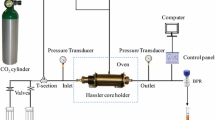Abstract
The Yangsanmu oilfield of Dagang is a typical heavy oil reservoir. After the maximum primary production (waterflooding), more than half of the original oil is still retained in the formation. Therefore, the implementation of an enhanced oil recovery (EOR) process to further raise the production scheme is inevitable. In this work, a novel in-situ CO2 foam technique which can be used as a potential EOR technique in this oilfield was studied. A screening of gas producers, foam stabilizers and foaming agents was followed by the study of the properties of the in-situ CO2 foam systems through static experiments. Core-flooding experiments and field application were also conducted to evaluate the feasibility of this technique. The results indicated that the in-situ CO2 foam system can improve both the sweep and displacement efficiencies, due to the capacity of this system in reducing oil viscosity and interfacial tension, respectively. The EOR performance of the in-situ CO2 foam system is better than the single-agent and even binary system (surfactant-polymer) flooding. The filed data demonstrated that the in-situ CO2 technique can significantly promote oil production and control water cuts. These results are believed to be beneficial in making EOR strategies for similar reservoirs.










Similar content being viewed by others
References
Wei B (2015) Flow characteristics of three enhanced oil recovery polymers in porous media. J Appl Polym Sci 132(10). doi:10.1002/app.41598
Bakhtiyarov S (2009) Core Flood Tests of in-Situ CO2 Generation Technology. In: ASME 2009 Fluids Engineering Division Summer Meeting, American Society of Mechanical Engineers
Bing W, Romero-Zerón L, Rodrigue D (2014) Evaluation of Two New Self-assembly Polymeric Systems for Enhanced Heavy Oil Recovery. Ind Eng Chem Res 53:16600–16611
Pu WF, Wei B, Jin FY, Li YB, Jia H, Liu PG, Tang ZJ (2016) Experimental investigation of co2 huff-n-puff process for enhancing oil recovery in tight reservoirs. Chem Eng Res Des. doi:10.1016/j.cherd.2016.05.012
Dyunushkin PI, Namiot AY (1978) Investigation of Conditions for Oil and CO2. Miscibility. Neft Khoz, Moscow 7:59–61
Glazova VM, Rizhik VM (1980) Implementation of CO2 Injection in the World. Neftepromislovoye Delo, VNIIOENG, Moscow, p 42
Khisamutdinov NI, Ibragimov GZ (1991) In: Telin AG (ed) Successive Injection of CO2 and Water to Improve Oil Recovery. VNIIOENG, Moscow p 62
Gumersky KH, Dzhafarov IS, Shakhverdiev AK, Mamedov YG (2000) In-situ generation of carbon dioxide: New way to increase oil recovery. In: SPE European Petroleum Conference, Paris, pp 24–25. SPE-65170-MS
Bakhtiyarov SI, Shakhverdiyev AK, Panakhov GM, Abbasov EM (2006) Oil Recovery by In-Situ Gas Generation: Volume and Pressure Measurements. In: ASME 2006 2nd Joint US-European Fluids Engineering Summer Meeting Collocated With the 14th International Conference on Nuclear Engineering, American Society of Mechanical Engineers
Bakhtiyarov SI, Shakhverdiyev AK, Panakhov GM, Abbasov EM (2007) Polymer/Surfactant Effects on Generated Volume and Pressure of CO2 in EOR Technology. In: ASME/JSME 2007 5th Joint Fluids Engineering Conference, American Society of Mechanical Engineers
Shiau BJB, Hsu TP, Roberts BL, Harwell JH (2010) Improved Chemical Flood Efficiency by In Situ CO2 Generation. In: SPE Improved Oil Recovery Symposium, Tulsa, pp 24–28 SPE-129893-MS
Lee HO, Heller JP (1990) Laboratory measurements of CO2-foam mobility. SPE Reserv Eng 5:193–197
Hoefner ML, Evans EM, Buckles JJ, Jones TA (1995) CO2 foam: results from four developmental field trials. SPE Reserv Eng 10:273–281
Chang SH, Grigg R (1999) Effects of foam quality and flow rate on CO2-foam behavior at reservoir temperature and pressure. SPE Reserv Eval Eng 2:248–254
Kim JS, Dong Y, Rossen WR (2005) Steady-state flow behavior of CO2 foam. SPE J 10:405–415
Cui L, Ma K, Puerto M, Abdala AA, Tanakov I, Lu LJ, Hirasaki G (2016) Mobility of ethomeen C12 and carbon dioxide (CO2) foam at high temperature/high salinity and in carbonate cores. SPE J
Chen Y, Elhag AS, Reddy PP, Chen H, Cui L, Worthen AJ, Nguyen QP (2016) Phase behavior and interfacial properties of a switchable ethoxylated amine surfactant at high temperature and effects on CO2-in-water foams. J Coll Interface Sci 470:80–91
Acknowledgments
The authors acknowledge financial support received from the National Key Basic Research Program of China (No. 2015CB250904). The valuable comments made by the anonymous reviewers are also sincerely appreciated.
Author information
Authors and Affiliations
Corresponding authors
About this article
Cite this article
Jin, F., Liu, Z., Pu, W. et al. Experimental Study of In-Situ CO2 Foam Technique and Application in Yangsanmu Oilfield. J Surfact Deterg 19, 1231–1240 (2016). https://doi.org/10.1007/s11743-016-1862-3
Received:
Accepted:
Published:
Issue Date:
DOI: https://doi.org/10.1007/s11743-016-1862-3




